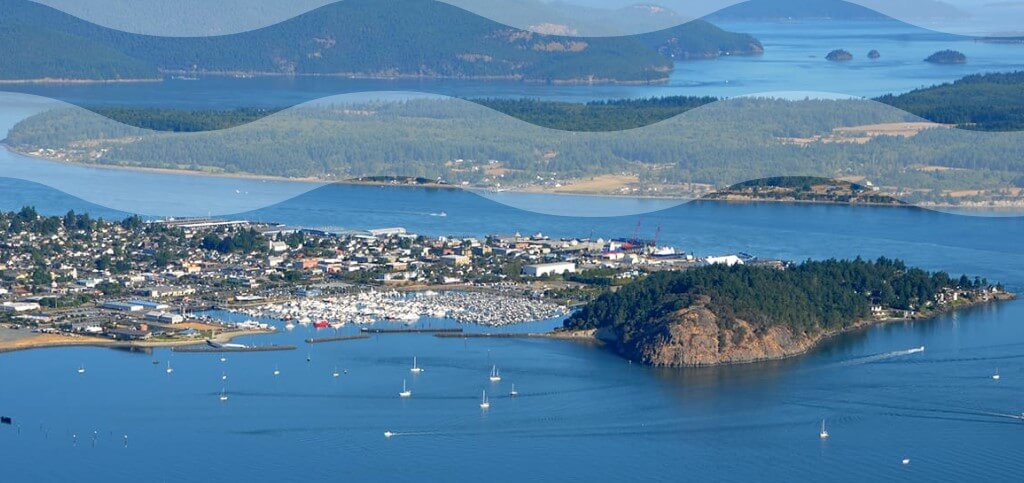In prime months, the lush San Juan Islands attract thousands of tourists. Visitors pack the ferry terminal on Fidalgo Island eager to hop to one of the other islands that dot the northwest Salish Sea. Ridership typically jumps about 50 percent in summer months, and rates follow; a car and a driver will pay from around $50 to $70 for a round trip this summer.

Originally published by the Washington Post on April 27, 2022, By M. L. Lyke
In prime months, the lush San Juan Islands attract thousands of tourists. Visitors pack the ferry terminal on Fidalgo Island, eager to hop to one of the other islands that dot the northwest Salish Sea. Ridership typically jumps about 50 percent in summer months, and rates follow; a car and driver will pay from around $50 to $70 for a round trip this summer.
The jumbo green-and-white ferries stop at four of the biggest islands in the San Juan archipelago: Lopez, Shaw, Orcas, and San Juan. Each island has its special charms.
Shaw is intensely private, with few visitor services except for one small grocery, a campground, and a park. The cloistered nuns who live there have found a perfect retreat.
Outgoing Lopez is known as the “Friendly Isle.” Drivers smile and wave at friend or stranger. It’s the flattest of the islands, great for biking, with pastoral fields dotted with sheep, charming old farmhouses, locally sourced restaurants and the tucked-away bed-and-breakfasts that characterize these bucolic islands.
San Juan Island draws lovers of the Northwest’s iconic orcas, a.k.a. killer whales. The island has a large fleet of whale-watching boats, a well-curated whale museum, and a shore-based orca-viewing park. The island’s lively downtown, Friday Harbor, offers fine-art galleries, boutiques, restaurants and pubs with local brews, though several buildings were destroyed in a recent fire.
Orcas Island, largest of the San Juan Islands, has a deep artistic groove expressed in lovingly tended gardens, galleries of fine pottery and paintings, farm-to-table restaurants, concerts and film festivals, and wildly creative parades and happenings. Well-maintained trails wind around lakes and up mountains to breathtaking views.
These serene islands offer endless beauty and respite. But in peak season — Memorial Day through Labor Day weekends — travelers can spend long hours queued up in their cars at the ferry terminal on Fidalgo Island. (Walk-ons pay less and stress less.) What many don’t realize is they are already in a Northwest paradise. It’s all around them, right there, on the island sometimes called the “First of the San Juans.”
Location: The San Juan Islands can be reached from the Anacortes Ferry Terminal at 5316 Ferry Terminal Rd. on Fidalgo Island. Check for updates at bit.ly/washington-ferries.
Fidalgo Island has its own scenic charms and the port city of Anacortes
First stop on a Fidalgo Island tour is Anacortes. The port city of about 18,000 has retained its salty, working-waterfront character even as it has gussied up in recent decades. Look down the main drag, past the upscale restaurants and shops, and you may see a massive 200-foot fishing trawler towering high in a boatyard dock.
Boats are everywhere, and there are numerous vessel slips in local marinas. If you like walking along docks, you’ll find Alaskan gill-netters, luxury cruisers, racing sailboats, and classic wooden rowboats. Adventurers can rent kayaks, solo or duo, or sign up for guided nature tours. And you don’t need to go to the San Juans to go whale-watching: Boats depart regularly from Anacortes spring through summer.
Old Town — a historical section of Anacortes with turn-of-the-century brick charm — invites slow strolling. Top-rated restaurants such as Adrift and A’Town Bistro serve beautifully prepared food that’s fresh from the sea and neighboring farmlands. Old Town streets are lined with art galleries, antique stores, bookstores, a restored 1890s hotel with spa, and niche shops with offerings such as designer clothes, charcuterie, and vinyl records.
Visitors are often stunned by the number of scenic nature trails that crisscross Fidalgo, covering miles of shore and forest. Paths lead to beaver ponds and reflection lakes, driftwood beaches, and old-growth forests. They zigzag up hills, reaching rocky balds with breathtaking 360-degree views.
One of Fidalgo’s crown jewels is 220-acre Washington Park, which looks out on the San Juan archipelago. Situated at Fidalgo’s west end, it shares much of the rest of the San Juans’ striking geology, flora, fauna, and wilderness vibe. Grabbing a west-facing park bench, visitors in the know can watch the crowded summer ferries thread their way out to the other islands and relax. They know that, without ferry or fuss, they’ve already arrived.
Location: Fidalgo Island is about 80 miles north of Seattle and connected by bridge to Skagit County and Whidbey Island.
Lyke is a writer based in the Pacific Northwest. Her website is marylynnlyke.com.
